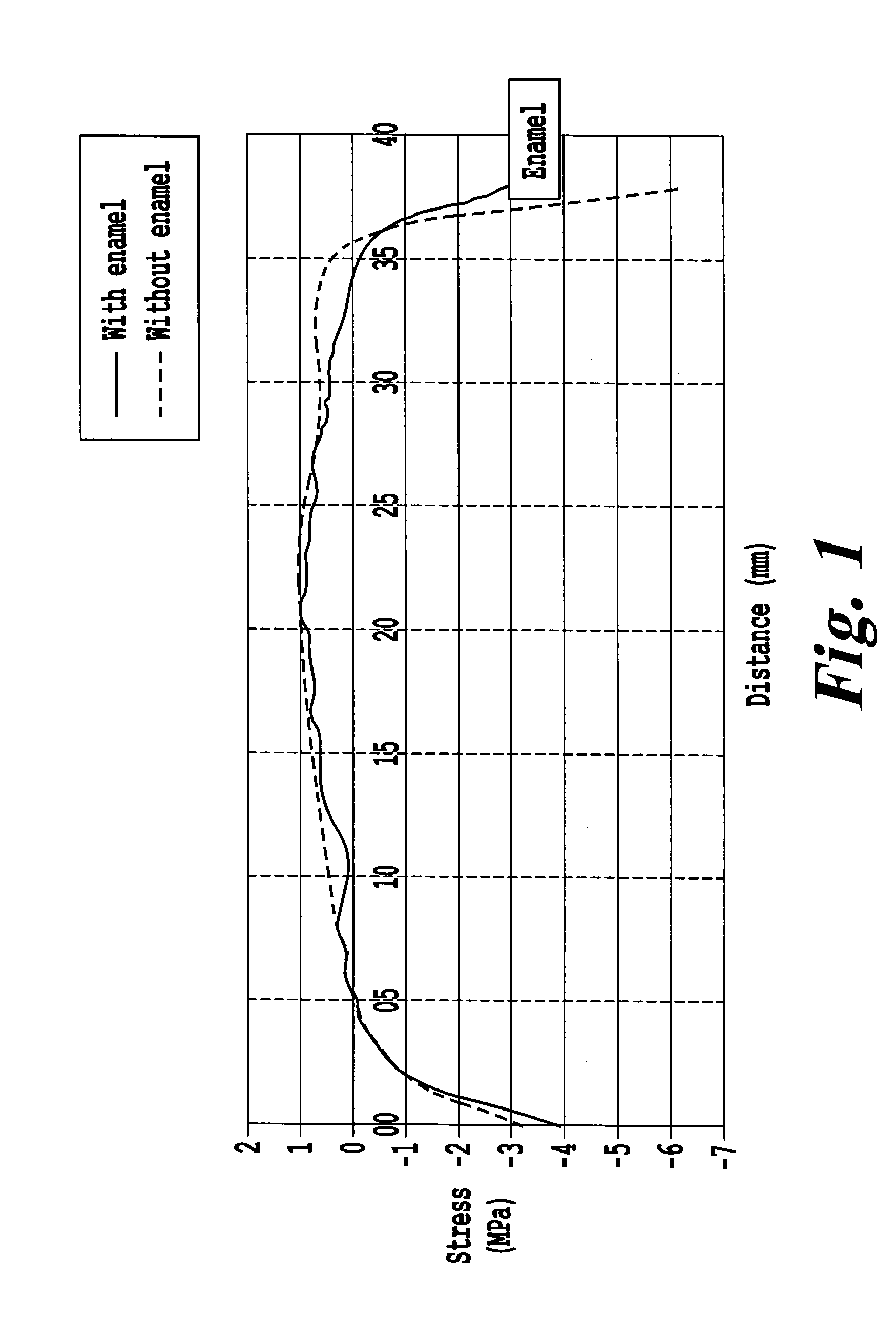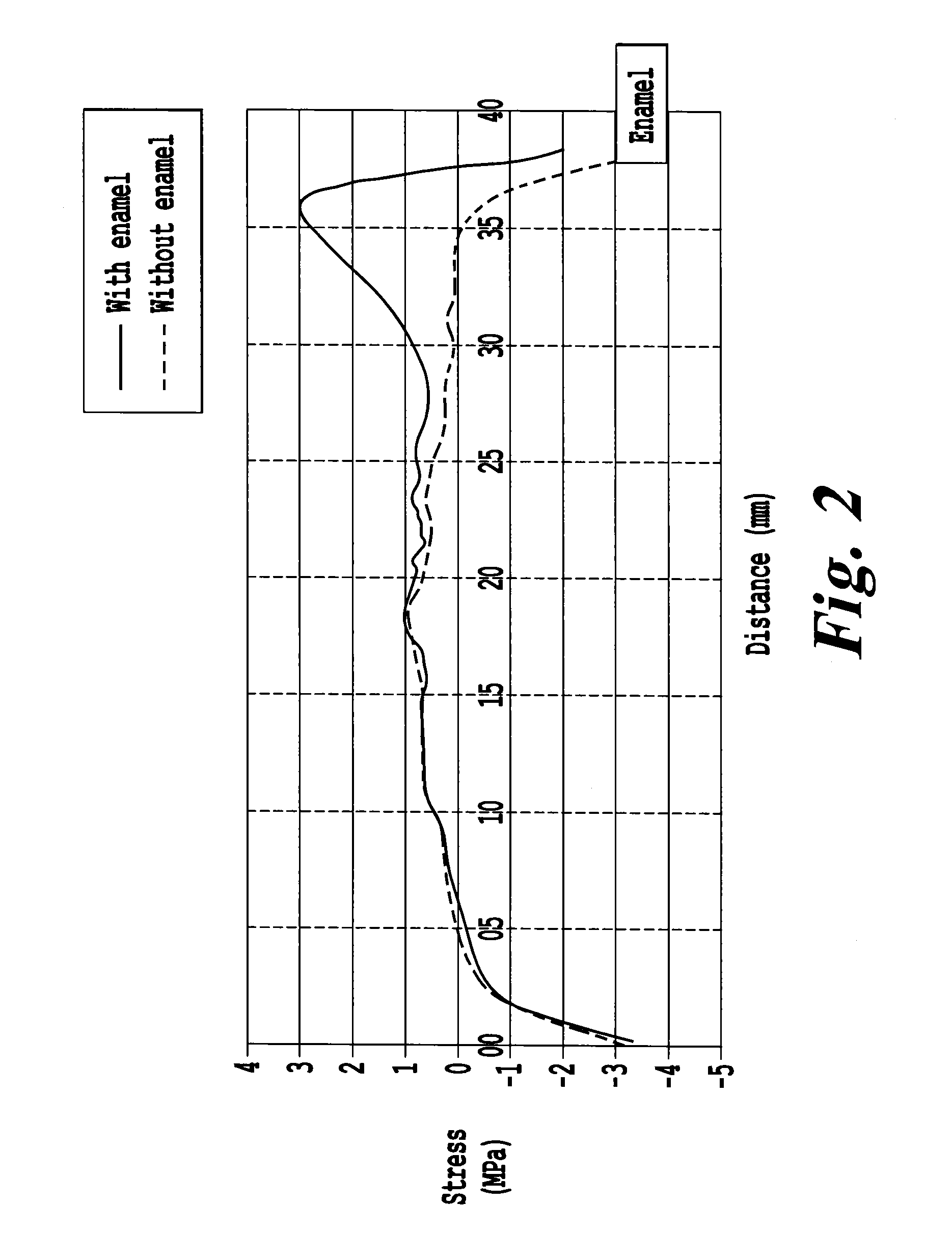Reinforced glass-ceramic article and enamel suitable for the coating thereof
- Summary
- Abstract
- Description
- Claims
- Application Information
AI Technical Summary
Benefits of technology
Problems solved by technology
Method used
Image
Examples
reference example 1
[0062]In the first reference example, the enamel used was a standard enamel based on a powder comprising 70% by weight of a glass frit having the following composition: SiO2: 41.7%; Na2O: 0.9%; K2O: 3.5%; Li2O: 2.1%; CaO: 2.8%; Al2O3: 18.5%; ZrO2: 2.4%; B2O3: 28% , said powder also comprising 30% by weight of TiO2 as pigment. The enamel (more specifically the glass frit forming said enamel) according to the present example had an expansion coefficient of the order of 52×10−7 K−1, and said enamel (or rather the glass frit forming said enamel) also had a dilatometric softening temperature of the order of 590° C. In this reference example, the enamel was deposited on the plate (of precursor glass or green glass or mother glass) before ceramization and baked during the ceramization, the thickness of the enamel layer after baking being around 3 μm.
[0063]The scale factor obtained (according to the Weibull model, after a bending test) was around 52 MPa, the Weibull modulus being equal to 1...
reference example 2
[0064]In the second reference example, the enamel used was a standard enamel based on a powder comprising 100% by weight of the glass frit described in reference example 1 (the expansion coefficient and the dilatometric softening temperature of the enamel being of the same order as in reference example 1). In this second example, the enamel was deposited on the already ceramized plate, the assembly being (re)baked at 800° C. for 30 minutes, the thickness of the enamel layer after baking being around 3 μm.
[0065]The scale factor obtained was around 80 MPa, the Weibull modulus being equal to 54.
reference example 3
[0066]In this third reference example, the enamel used was a standard enamel based on a powder comprising 100% by weight of a glass frit having the following composition: SiO2: 48.6%; MgO: 3.8%; Na2O: 2.6%; K2O: 3.3%; Li2O: 1.3%; CaO: 0.6%; BaO: 17.8%; Al2O3: 7.1%; ZrO2: 1.7%; ZnO: 8%; B2O3: 5.4% . The enamel according to the present example had an expansion coefficient of the order of 75×10−7 K−1 and a dilatometric softening temperature of the order of 600° C. In this third example, the enamel was deposited on the plate (green glass or mother glass) before ceramization and baked during the ceramization, the thickness of the enamel layer after baking being around 3 μm.
[0067]The scale factor obtained was around 88 MPa, the Weibull modulus being equal to 27. The thickness stress profile in the glass-ceramic is given in FIG. 1, in which the presence of a maximum tension in proximity to the enameled surface is not observed, the maximum stress value being around 0.9 MPa. In comparison, t...
PUM
| Property | Measurement | Unit |
|---|---|---|
| Temperature | aaaaa | aaaaa |
| Temperature | aaaaa | aaaaa |
| Fraction | aaaaa | aaaaa |
Abstract
Description
Claims
Application Information
 Login to View More
Login to View More - Generate Ideas
- Intellectual Property
- Life Sciences
- Materials
- Tech Scout
- Unparalleled Data Quality
- Higher Quality Content
- 60% Fewer Hallucinations
Browse by: Latest US Patents, China's latest patents, Technical Efficacy Thesaurus, Application Domain, Technology Topic, Popular Technical Reports.
© 2025 PatSnap. All rights reserved.Legal|Privacy policy|Modern Slavery Act Transparency Statement|Sitemap|About US| Contact US: help@patsnap.com



